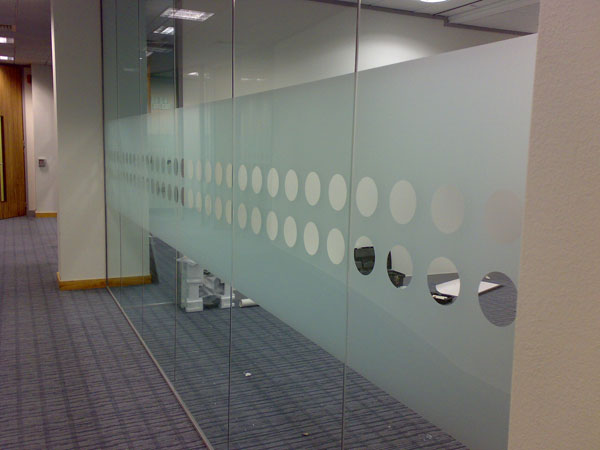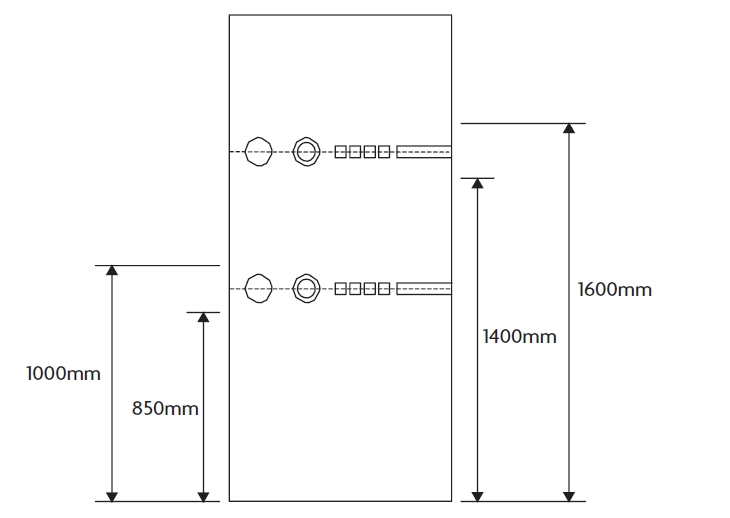Glass manifestation
Manifestation is a treatment that can be applied to glass windows, doors, partitions and any other large expanses of clear glass, in order to make the glass visible, preventing injury through collisions. It can also help enhance privacy and can be decorative.
Manifestation is typically created from a frosted film applied at specified locations on clear glass to make it more easy to detect.
Building regulations requirement K5.2: Manifestation of glazing, states that:
| Transparent glazing with which people are likely to come into contact while moving around in or about the building, shall incorporate features which make it apparent. |
Approved document K, Protection from falling, collision and impact, suggests that this requirement will be satisfied by including permanent means of indicating the presence of large uninterrupted areas of transparent glazing, and Section 7 of the approved document provides further details, requiring that either:
| They are clearly defined with glass manifestation on the glass at two levels; between 850-1,000 mm and 1,400-1,600 mm above the floor, contrasting visually with the background seen through the glass (both inside and out) in all lighting conditions. Manifestation takes the form of logo or sign at least 150 mm high (repeated if on a glazed screen), or a decorative feature such as broken lines or continuous bands, at least 50 mm high. |
The most simple manifestation is two rows of 50-75 mm white or frosted dots, however, the regulations do not dictate the appearance of the manifestation. Standard designs of dots, squares and simple bands are common, but large panels in etched or printed film with cut-out clear spaces, or branded manifestation with logos or other designs are also acceptable.
Alternative solutions such as mullions, transoms, door frames or large pull handles / push plates may also be acceptable.
In addition, doors should be apparent from the side, if they can be held open, and where glazed doors are beside a glazed screen, they should be marked with a high contrast strip along the top and at both sides.
The approved document to Part M of the Building Regulations - access to and use of buildings - states that people with visual impairment should be in no doubt as to the location of glass doors and screens, and steps should be taken to avoid people being harmed by walking into them. This requirement is satisfied if they comply with approved document K, section 7.
[edit] Related articles on Designing Buildings Wiki
Featured articles and news
RTPI leader to become new CIOB Chief Executive Officer
Dr Victoria Hills MRTPI, FICE to take over after Caroline Gumble’s departure.
Social and affordable housing, a long term plan for delivery
The “Delivering a Decade of Renewal for Social and Affordable Housing” strategy sets out future path.
A change to adoptive architecture
Effects of global weather warming on architectural detailing, material choice and human interaction.
The proposed publicly owned and backed subsidiary of Homes England, to facilitate new homes.
How big is the problem and what can we do to mitigate the effects?
Overheating guidance and tools for building designers
A number of cool guides to help with the heat.
The UK's Modern Industrial Strategy: A 10 year plan
Previous consultation criticism, current key elements and general support with some persisting reservations.
Building Safety Regulator reforms
New roles, new staff and a new fast track service pave the way for a single construction regulator.
Architectural Technologist CPDs and Communications
CIAT CPD… and how you can do it!
Cooling centres and cool spaces
Managing extreme heat in cities by directing the public to places for heat stress relief and water sources.
Winter gardens: A brief history and warm variations
Extending the season with glass in different forms and terms.
Restoring Great Yarmouth's Winter Gardens
Transforming one of the least sustainable constructions imaginable.
Construction Skills Mission Board launch sector drive
Newly formed government and industry collaboration set strategy for recruiting an additional 100,000 construction workers a year.
New Architects Code comes into effect in September 2025
ARB Architects Code of Conduct and Practice available with ongoing consultation regarding guidance.
Welsh Skills Body (Medr) launches ambitious plan
The new skills body brings together funding and regulation of tertiary education and research for the devolved nation.
Paul Gandy FCIOB announced as next CIOB President
Former Tilbury Douglas CEO takes helm.
UK Infrastructure: A 10 Year Strategy. In brief with reactions
With the National Infrastructure and Service Transformation Authority (NISTA).

























Comments